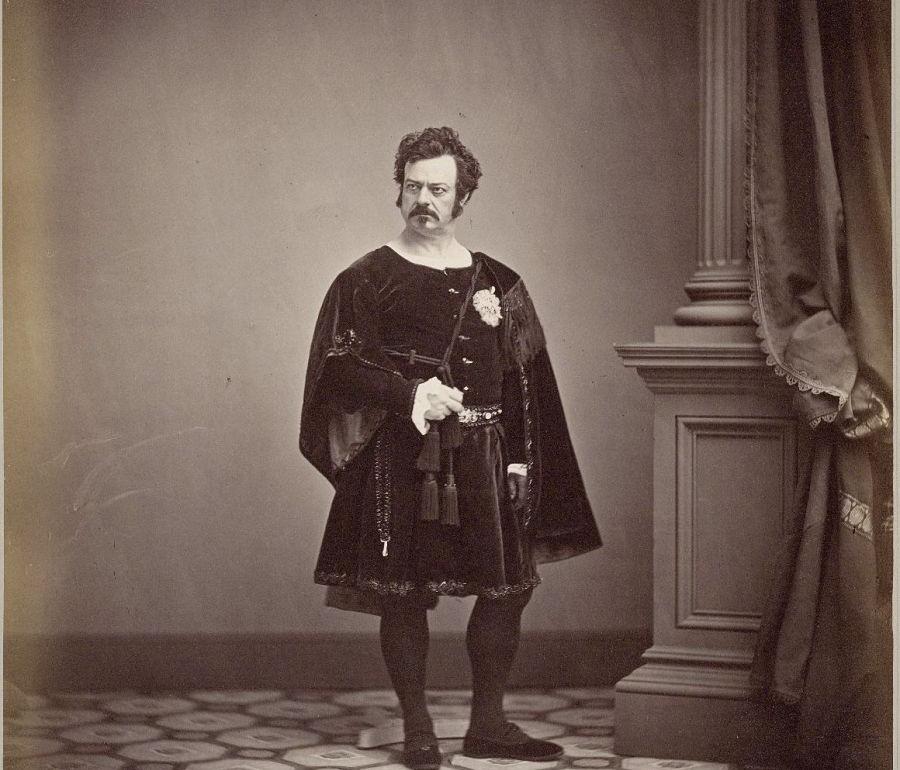210 YEARS AGO (1806)
Edwin Forrest, often considered the first American theatre star, is born in Philadelphia. By the age of 20, Forrest will perform Othello at the Bowery Theatre in New York City, establishing his passionate acting style. In 1837, The New York Mirror will write that, despite the performer’s young age, his acting possesses “a brilliancy of genius, a depth of feeling, and acquaintance with the workings of the human soul; and a grasp of intellect, which already rank him among the greatest.” Though Forrest will later spark the Astor Place Riots in 1849, he will continue to perform in New York until his death in 1872.
150 YEARS AGO (1866)
At the Boston Theatre, former child performer Louis Aldrich gets his big break in Leah the Forsaken. Kate Bateman, who portrays the title character, has already achieved some of her greatest success in the role, and at the last minute the 22-year-old Aldrich fills in for the actor playing Nathan. Aldrich, who grew up in Ohio, will remain with the theatre’s resident stock company for eight seasons, and he will go on to cultivate a national reputation, in addition to holding officer positions in the Actors Fund of America. His efforts to create a facility for retired theatre professionals will lead to the establishment of the Lillian Booth Actors Home in Englewood, N.J.
100 YEARS AGO (1916)
The management of the Lafayette Theatre in Harlem purchases the Anita Bush Players (also known as the Anita Bush Stock Company), and with permission from Bush, who founded the troupe in 1915, changes their name to the Lafayette Players. Despite the shift in ownership, Bush oversees most of the programming for the group, which will become one of the nation’s most widely known black dramatic stock companies. Bush will remain with the troupe until 1920, when she begins appearing in films such as The Crimson Skull (1921), the first all-black western.
95 YEARS AGO (1921)
The Hanna Theatre in Cleveland opens its doors. Orginally a 1,397-seat space, it will host such performers as Ethel Barrymore, Al Jolson, Helen Hayes, Mary Martin, and Yul Brynner. After a 2008 renovation in which a thrust stage is installed and the auditorium is reconfigured to seat 550, the Hanna will become the home of Great Lakes Theater.
50 YEARS AGO (1966)
The League of Resident Theatres is established in order to negotiate with Actors’ Equity Association to form a standard contract for performers appearing at resident companies. Until this point, resident theatres worked out actor contracts on a case-by-case basis, often adapting commercial theatre agreements. LORT’s first president is Peter Zeisler, who in 1972 will become executive director of Theatre Communications Group, a post he will hold until 1995. Among the original LORT member organizations are the Alley Theatre in Houston, Milwaukee Repertory Theater, and Center Stage in Baltimore.
45 YEARS AGO (1971)
During a matinee performance of 70, Girls, 70 at the Forrest Theatre in Philadelphia, actor David Burns falls over in the scene after his big song, “Go Visit Your Grandmother,” and dies offstage. The Kander and Ebb show is in the middle of its pre-Broadway tryout, and the 68-year-old Burns was brought in to replace leading man Eddie Foy, who was deemed not healthy enough to continue in the role. Among his many credit, Burns originated the role of Horace Vandergelder in Hello, Dolly! and remained in the part for three years. In her New York Times obituary of Burns, Carol Channing will describe the way the two of them reacted to the news of John F. Kennedy’s assassination during Dolly’s pre-NYC run in Detroit: “Davey handed me Kleenex and fed me lines. We decided then and there that the lucky ones ‘died with their boots on.’”
30 YEARS AGO (1986)
The Colored Museum has its world premiere at Crossroads Theatre Company in New Brunswick, N.J. Through a series of “exhibits” that parody popular images of and stereotypes of African Americans, playwright George C. Wolfe explores the complexities and tensions of black life. The play quickly moves to New York City’s Public Theater, where it will garner critical acclaim and spark controversy within the black community. Wolfe will go on to have a long Broadway career, directing productions such as Jelly’s Last Jam, Angels in America, Bring in ’da Noise, Bring in ’da Funk, Topdog/Underdog, Carolin, or Change, and the 2016 revival of Shuffle Along.
20 YEARS AGO (1996)
The Los Angeles Women’s Shakespeare Company presents an all-female Richard III at the Gascon Center Theatre in Culver City, Calif. Lisa D. Horowitz writes in her Variety review, “One quickly becomes oblivious to the actors’ gender, because the performances are generally fine and convincing regardless of sex.” In the title role, the show features LAWSC producing artistic director Lisa Wolpe, who will later say of the company’s work, “We have gay women and straight women working happily together—some bring their kids to the production, and some bring their girlfriends.” She adds, “In the rehearsal room, there is respect, humor, and an excitement at the permission to play with other women without having guys around to define a traditional hierarchy and sexuality. As a result, a tremendous power arises in the exploration of who these women really are.”


